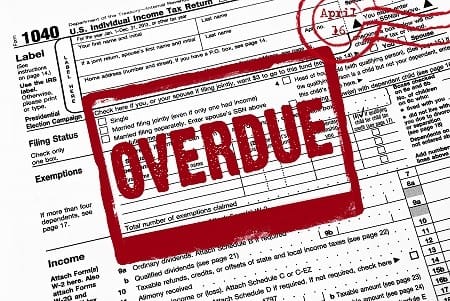
IRS payment plans or installment agreements are agreements between the taxpayer and the IRS wherein the taxpayer agrees to make regular monthly payments to the IRS until the balance is paid in full.
In general, all IRS payment plans are either long-term installment agreements (monthly payments), short-term payment plans (multiple lump sum deposits within 180 days), or single payments (paying off a tax debt in one deposit or check).
For larger debts, most taxpayers are forced to consider long-term installment agreements. While the length of the agreement depends on the circumstances and terms to which the taxpayer agrees with the IRS, the default length of any installment agreement is 72 months, or six years.
If a taxpayer’s tax debt has been ongoing for a few years, then the length of the agreement corresponds to the remainder of time left before the debt expires or reaches its Collection Statute Expiration Date (CSED).
Understanding Tax Penalties and Interest
When it comes to dealing with the IRS, understanding your options is crucial.
If you’re unable to pay your tax debt in full, don’t panic! The IRS offers a variety of payment plans and installment agreements that allow taxpayers to gradually pay off their balance over time.
These agreements range from short-term payment plans to long-term installment agreements that can last up to six years.
The IRS calculates the amount of the monthly payment for each person based off of the taxpayer’s income, allowable monthly expenses, and the time remaining in their Statute of Limitations.
A tax debt expires after ten years plus tolling from its tax assessment date – the date on which the IRS determines the debt, not the date on which you received your notice of tax debt. As such, most installment agreements generally fit into a tax debt’s total lifespan.
If your tax debt is significantly older, you may be entitled to different payment options. It’s important to work with a professional to determine which type of plan is best for you, and how to proceed.
There are various IRS Payment Programs available to taxpayers, such as:
Streamlined Installment Agreement

For taxpayers who have a tax debt under $25,000, a simple Streamlined Installment Plan can be applied for with IRS Form 9465.
Payments for this agreement will be calculated using a 72-month payment plan, or divided by the months left in the Statute of Limitations for the debt, if less than 6 years.
Streamlined installment plans with a total tax debt of $25,000 or less are entitled to a simplified application process, which can be completely entirely online as well.
There are very few forms to fill out in comparison to other tax debt payment plans, and you do not need to submit to a thorough financial checkup. However, the IRS may still place a federal tax lien on your account until your debt is completely paid, or until you have made at least a few back-to-back payments with no history of defaulting.
If you owe more than $25,000, but less than $50,000, you are still entitled to a streamlined installment agreement, but with an additional caveat. This is where the Fresh Start initiative comes into play.
Fresh Start Streamlined Installment Plan

An extension of the Streamlined IRS payment plan, this program is for taxpayers who owe between $25,001 and $50,000. Limited financial information may be required due to the higher debt amount involved.
Furthermore, taxpayers who owe up to $50,000 are required to agree to a Direct Debit installment agreement or a Payroll Deduction installment agreement.
This means that instead of making voluntary payments, a taxpayer in a streamlined installment agreement with a debt between $25,001 and $50,000 must agree to allow the IRS to automatically withdraw monthly payments from a specified bank account, or immediately withdraw the monthly installment from every paycheck.
Payments are calculated in the same manner as the Streamlined Installment Agreement, meaning the total debt is divided into 72 individual payments, or however many months are left until the debt expires.
Non-Streamlined Installment Agreement

This type of monthly payment plan is available only to taxpayers who owe more than $50,000.
Because this level of debt is higher, the IRS requires a formal Installment Agreement Request, as well as a thorough Collection Information Statement (CIS), which includes a complete financial and tax assessment, giving the IRS a better picture of your details and how you intend to pay off your debt.
Unlike a streamlined installment agreement, a non-streamlined installment agreement cannot be setup online.
You must set it up via the usual paper trail, using physical forms and supporting documents for your CIS. The IRS will usually apply a federal tax lien on your account as well.
Partial Payment Installment Agreement

This program was introduced in 2005 as a partial settlement/payment plan for taxpayers who owe more than they can pay before their Statute of Limitations expires.
Taxpayers will need to provide documented proof of their inability to pay, as well as a letter explaining their current financial situation.
The IRS will determine, through a full disclosure of financial documents, the monthly payment amounts. Once the terms of the Partial Payment Agreement are fulfilled, the remainder of the tax debt is forgiven.
Tiered Installment Plan
For taxpayers who owe less than $25,000 and have temporary financial difficulty paying their tax debt, a Tiered Installment Plan is suggested.
With this program, the IRS will set low monthly payments for the first year of the agreement, with the payments increasing over time until the agreed pay-off amount is reached.
The purpose of a tiered installment plan is to give low-income taxpayers a chance to get back on their feet and focus on improving their financial situation, while still paying down their tax debt, and keeping the IRS off their back with additional collection actions.
Not all installment agreements are created equally. You can work with a tax professional to determine an installment agreement that better suits your needs, such as increasing your monthly payments to pay off your debt faster at a higher monthly cost or making lump sum payments to the IRS BEFORE applying for an installment agreement, so you can slip under the $50,000 threshold and avoid a much more thorough and headache-inducing Collection Information Statement.
Offer in Compromise
If your current financial situation is especially dire, you should ask a tax professional about considering an Offer in Compromise.
This is a special installment agreement that can severely cut down what you owe, but with very stringent requirements.
To qualify for an Offer in Compromise, you must fill out a special Installment Agreement Request along with a unique OIC-specific Collection Information Statement. The IRS will use the information outlined on this special CIS to determine whether your finances support the offer you have outlined in your request.
Unlike other installment agreements, an OIC has no strict guidelines on the taxpayer’s end. However, the IRS can choose to accept or discard your offer.
To create an offer the IRS will be more likely to accept, you must determine your own Reasonable Collection Potential (RCP). This is effectively the sum of every liquid asset you possess, along with the quick sale value of every property you own, and your current disposable or net income (anything earned after taxes), with very few exemptions.
If the IRS determines that you cannot pay off your entire tax debt even on a shoestring budget, then your RCP will be used as a baseline for what to expect from a monthly installment plan.
Any offer that drops below the IRS’ calculated RCP (based on the information you provide) will generally be rejected.
The Role of a Tax Professional in Determining Your Monthly Payment Plan
Creating your own OIC can be difficult. Consider consulting a tax professional first, to determine whether an offer in compromise is currently in your best interests.
If you owe the IRS money, then getting in touch with an experienced team of tax professionals can help you minimize your debt, avoid wasted time, and identify the best possible IRS payment plans for your individual circumstances.
We can help you figure out whether a streamlined plan is best for you, or whether you qualify for partial payment, an offer in compromise, or a lump-sum agreement.
Furthermore, investing in IRS payment plans as soon as possible can minimize IRS penalties and interest, and help you shorten the duration of your potential tax lien, and avoid a wage garnishment, bank levy, or other IRS collection actions.
Don’t wait!
Let the Licensed Professionals at Rush Tax Resolution analyze your personal tax situation and negotiate the best possible IRS payment plans for you.
We Are The Experts – Contact Us Today!
GET HELP NOW!

